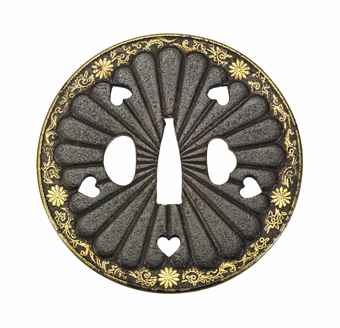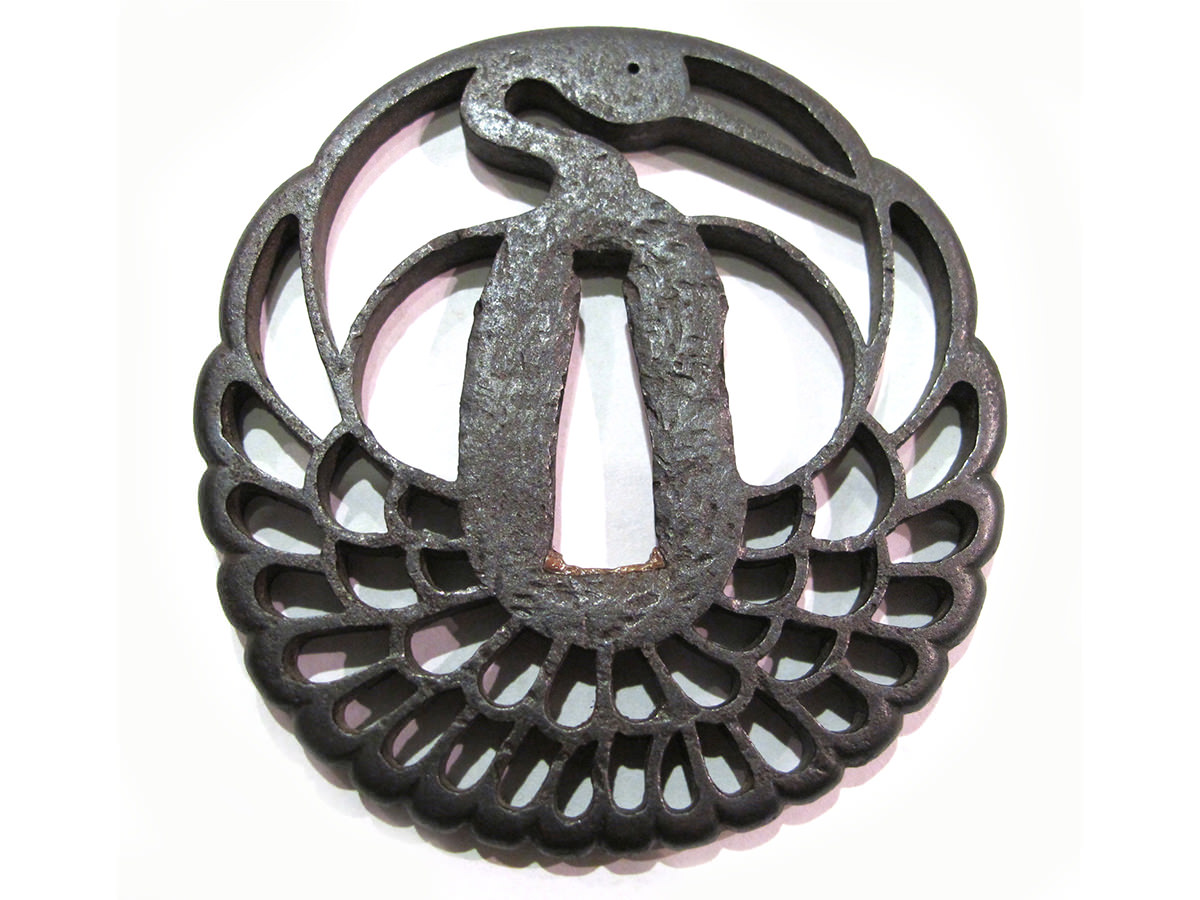Legends And Stories In Tsuba
Legends And Stories In Tsuba
By Clive Sinclaire
In the last Programme, I profiled ten tsuba from my collection and attempted to describe and explain the legends and features depicted on them. In this issue, I have continued the theme with a few more. Once again I have avoided overly technical descriptions of most features, because of a lack of expertise in this area. Also, classification and history of schools is avoided except when obvious. I would welcome any comments or additional information that members may care to provide.
Iron Squared Tsuba.

The Nara school was founded in Edo in the first half of the 17th century by Nara Toshiteru and was influential in metalwork throughout the Edo period. This design may be a “standard” school design as exactly the same design together (except in the round) with the same three character mei is illustrated in Robinson’s Arts of the Japanese Sword.
Plum blossom, along with a seemingly endless list of other things, is associated with longevity and the plum tree or blossom is the subject of many poems. One, occasioned by a daimyo who wanted a branch from a flowering tree was put off by the owner of the tree in the form of a verse meaning; “If the branch is broken, where will the Otoguisu (nightingale) find a resting place on its return?”
Sennin Sonkei composed a poem with a more obscure meaning, which translates as; “ If I sit on a pine root I shall live for 1,000 years; if I place a sprig of plum in my hair, the snow of February will fall on my sleeves”. This refers to the fact that the second month of the lunar calendar is known as the month of plum blossom viewing and plum blossom is the most representative flower of the second month. Their strength against cold winds and other winter adversities such as frost and snow, together with their pure and fragrant blossoms, most adequately symbolises the noble and proud spirit of the warrior class. I hope that such important foul weather advice will be of use to the reader.
Ex Newman Collection (1973)
Kani Sukashi Tsuba

The surface of the iron has a rich dark patination and the whole work gives the impression of strength and power with good use of the empty space.
The Kani (crab) was highly regarded by the samurai. It was heavily armoured and its claws are fearsome weapons. As such it was also depicted on Kawari-kabuto (decorative and elaborate helmets) of the late Muromachi period. In Japanese legend and art it is often shown with a monkey with which it constantly feuded.
However, the most poignant legendary attribute of the kani is the Heike-kani. The Taira clan (the Heike) suffered a crushing defeat at the hands of the Minamoto at the battle of Dan-no-ura (present day Shiminoseki) in 1185 and the majority of their warriors went to a watery grave. Even to this day, it is believed that the crabs in the seas and on the beaches surrounding Shimnoseki, are the ghostly reincarnations of the souls of these long lost warriors and every night they vainly attempt to bail out their boats at the bottom of the sea with bottomless ladles.
Gift 1992
Shakudo Wakizashi Tsuba

It is incredible that such fine detail and skilful work was done by one as young as seventeen and I afraid that I have been unable to trace any record of Munemitsu.
Jo and Uba (collectively Jotomba) are an old couple, usually depicted raking and gathering pine-needles. According to Joly: “ At Takasago there is a very old pine tree, the trunk of which is bifurcated; in it dwells the spirit of the Maiden of Takasago, who was seen once by the son of Izanagi, who fell in love and wedded her. Both lived to a very great age, dying at the same hour on the same day, and ever since their spirits abide in the tree, but on moonlight nights they return to human shape and revisit the scene of their earthly felicity and pursue their work of gathering pine-needles.
At weddings the Takasago no Utai is recited, and the figures of Jotomba, called Shimadai, are gathered in the wedding room.” Once again, longevity is associated with Jo and Uba.
Ex Gardiner Coll (No 1549)
Ex Peak Coll
Ex Newman Coll (No. 293) – Glendenning 1949
Shoami Tsuba
Catalogue description, Christies July 1982:

This tsuba has a plain iron ground with a raised rim that has a crinkled effect on its inside edge. The front shows Fukurokuju in the bottom right-hand corner with a shakudo cloth covering his extended head. He is holding a makimono and the design of his clothing is finely chiseled whilst his sleeve is highlighted in gold. He is being watched by a copper headed crane in the opposite corner, whose feathers are delicately carved and whose eye and visible leg are in gold. Both crane and figure are in relief.
The reverse shows a mimogawa with a gold shell under the branch of an incised pine-tree. It is on this side that the neatly carved signature may be found. The smooth iron plate has a good deep, brown patination and all three ana (kodzuka, kogai and nakago) appear rather small for the size of the tsuba. Probably late 18th or 19th century.
According to Sasano, the ami of the Shoami name, derives from Amida Buddha and was used to indicate priestly rank in the Jishu sect. Later the name was incorporated into artistic names of those serving the shogunate, for instance the sword appraising family of Honami. The name Shoami was used to indicate a silversmith from the period of the Ashikaga shogunate onwards.
From the beginning of the Edo period it appears many Shoami family tsuba makers moved from Kyoto to many provinces around the country, such as Aidzu (Mutsu province) Tsuyama (Mimosaka) Matsuyama (Iyo province) and of course the capital, Edo. Haynes quotes one Shigechika as being part of the later Bushu (Edo) group. The Shoami were a very and large and prolific group and it is considered by many experts that much of their work is of second rate quality, deteriorating even more with the later generations.
Fukurokuju is a benign fellow and one of the sevens gods of good luck. He is a bearded old man and the God of Longevity and so is often accompanied by a crane and a mimogawa, as is the case here. He is immediately identifiable by his extremely large and elongated cranium and he is often depicted in humorous situations. Young boys may climb over his head and play with him attaching a scarf around his head in a modified form of Kubi Kubi (neck pulling). They may even climb onto his head and shave it or Fukurokuju might demonstrate his calligraphy skills by tying a brush to his head. As part of the Shishi Fukuji (seven lucky gods) he may be found in the Tarakabune or treasure ship and he may exorcise the Oni on New Years Eve.
Daisho Tsuba

The base of these two round (maru-gata) tsuba are a richly patinated iron, upon which are two Chinese nobles and an ox or buffalo. The two figures are dressed in gold robes and their faces and visible limbs are depicted in silver. The ox is entirely in shakudo. The scene is a rocky landscape and a waterfall with gilt and shakudo details. The figure at the top is sitting next to the waterfall, one hand to his ear and the other in the water. The lower figure holds a rope, which is round the neck of the ox. There are two hitsu-ana, the kogai aperture being of an irregular shape formed by then craggy rock formation. The design is carried through onto the reverse, the lower figure’s back being seen through the kogai-ana. Although not identical, these details are common to both pieces and form an obvious daisho.
Ex: Sir John Liberty sale
Ex: Newman Collection, 1973
Probably 18th century Nara work.
The subject of the composition is taken from ancient Chinese mythology, popularly dating back to 2,360 BC. The higher figure is one Kioyu (or Ha Yeo) who was an adviser to the Emperor Yeo. The story goes that on a certain day, the Emperor suggested that he might abdicate in favour of Kioyu. On hearing this Kioyu was greatly shocked as he considered the suggestion to be heresy. His reaction was to rush to the nearest waterfall to wash out his ears, which he considered had been defiled by hearing such temptation. Kioyu’s best friend, a certain Sofu (or Ch’ao Fu) on hearing of Kioyu’s urgent and hurried ablutions, felt that he needed to go one better and immediately went to wash both his ears and eyes of the taint of ambition, which he felt he was contracting from his friend. As he was washing, Sofu noticed that downstream from the waterfall, his ox was drinking from the same stream. As he considered that the water was now polluted by his own washing, he rushed down to the ox and led it away from the water.
This is the tale illustrated on this tsuba. When incorporated in Japanese art it represents virtue at its most extreme.
Tsuru Tsuba

Of these two, the quality of the Higo tsuba does not compare well with the Miochin example. The Miochin has better quality of iron and the carving is far finer than that of the supposedly Higo example. However, I am sure the reader will see immediately where the inspiration for Japan Airline’s tail-fin logo may have come from.
The Miochin tsuba depicts “cranes suivant” and the delicate carving shows each feather and feature individually. Both hitsu-ana are formed by the beaks and feet of the birds. The entire composition gives a feeling of movement, whilst that of the mumei Higo piece looks rather stiff and forced.
The Miochin piece is thought to be late 17th century work and is signed Esshu ju Yoshihisa saku on the seppa-dai. Although the Miochin family were famous as armour makers, Yoshihisa is not listed in their genealogy and so it is probable that he was a dedicated tsuba-maker. It should also be noted that no tsuba bearing the name “Miochin” were made before the beginning of the Edo period. There also seems to be quite a close relationship between the Miochin and the Kinai who both hale from the same province of Echizen.
Ex Parflow Collection,
Ex Branford Collection,
Ex Newman 1973 (Glendenning 1952)
Ex Dene, 1984 (Higo Tsuba)
Living for a thousand years, and being the attribute of many deities and mythological figures, it is quite surprising that the Japanese almost hunted these grateful birds to extinction in the Meiji period. Indeed the tsuru is almost as much of an image of Japan as is Mt Fuji, appearing today on airlines, sake-bottles, wedding kimono. Indeed the list goes on, even appearing on the Yen 10,000 bank note.
Before the Meiji period, this bird was quite common although it’s meat was reserved exclusively for Imperial consumption. After the restoration and the lifting of many feudal restrictions, this sacred bird became the favourite target for hunters who slaughtered it almost to the point of extinction with the exception of a few who survived in the underdeveloped Eastern Marshes of Hokkaido. It was then further endangered as a result of rampant land development even in this remote region. Fortunately, in very recent years, protection has now stabilised the population and it appears to have survived.
Bibliography:
Joly – Legend in Japanese Art
Sasano: Sukashi Tsuba
Robinson: Arts of the Japanese Sword
Haynes: Tsuba, an Aesthetic Study
Insight Japan
NB: Please note all illustrations are not necessarily to actual size
Copyright ©2004 Clive Sinclaire. All rights reserved.







